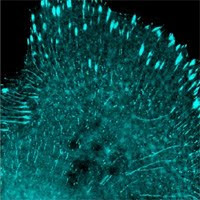The ballot is in—among the “usual suspect” hot topics, iPS takes the top honor and most entries; Camelid antibodies, although not really presented as a typical AlleleBlog in 2011, made it to the top 3. shRNA cloning and RNAi screening are still on a lot of people’s minds, so it seems.
Method: total visits to each blog since our new webpage was launched in July was counted.
1) Fusion of the Transcription Domain to iPS Factors Radically Enhances Reprogramming
http://blog.allelebiotech.com/2011/10/fusion-of-the-transcription-domain-to-ips-factors-radically-enhances-reprogramming/
2) Methods of iPSC Generation Update
http://blog.allelebiotech.com/2011/08/methods-of-ipsc-generation-update/
3) About 50 Papers Cited the Use of GFP-Trap Camelid Antibody So Far in 2011
http://blog.allelebiotech.com/2011/09/about-50-papers-cited-the-use-of-gfp-trap-camelid-antibody-so-far-in-2011/
4) Big Potential in Using Protozoans for Producing Mammalian Proteins
http://blog.allelebiotech.com/2011/09/big-potential-in-using-protozoans-for-producing-mammalian-proteins/
5) How do you make shRNA-expressing viruses for function screening?
http://blog.allelebiotech.com/2011/11/how-do-you-make-shrna-expressing-viruses-for-function-screening/
6) Creating ground-state human iPSCs
http://blog.allelebiotech.com/2011/10/creating-ground-state-human-ipsc/
7) Recombinase-Mediated Cassette Exchange (RMCE) and Integrase Swappable in vivo Targeting Element (InSITE)
http://blog.allelebiotech.com/2011/03/recombinase-mediated-cassette-exchange-rmce-and-integrase-swappable-in-vivo-targeting-element-insite/
8) Development of Cell Lines from iPSCs for Bioassays
http://blog.allelebiotech.com/2011/11/development-of-cell-lines-from-ipscs-for-bioassays/
9) Choosing siRNA, shRNA, and miRNA for Gene Silencing
blog.allelebiotech.com/2010/02/choosing-sirna-shrna-and-mirna-for-gene-silencing/
10) Allele Biotech’s Box Swap Program
http://blog.allelebiotech.com/2009/07/allele-biotechs-box-swap-program/
Have a successful 2012!
From AlleleBlog: http://blog.allelebiotech.com/2011/12/top-10-list-of-most-viewed-alleleblogs-in-2011/
Saturday, December 31, 2011
Monday, December 26, 2011
“活着”之后的张艺谋和谈论“革命”、“民主”、及“自由”的韩寒
张艺谋的“活着”可以说是中国当代电影中最深刻、最有影响力的、反应中国近代社会、历史的作品之一。它在中国的禁演减小了其影响力,在时间上也似乎把张导演的电影生涯画了一条界线----之前的张艺谋作品是给大众看的;之后的是为了掌权者或投资人而让大众看的。比如《英雄》的唯一思想就是“秦王不能杀”,即使他施行暴政、残忍肆虐,但他有一个“打下很大的天下”的宏大志向,用现代的话说叫“正在下一盘很大的棋”。其实纵观人类现代史,顶尖的恶魔大都也有这样的宏大志向及信心、耐力、甚至智慧去实现(或几乎实现或暂时实现)其志向,比如希特勒、波尔布特、等等。张艺谋之后的开幕式、《黄金甲》,不用重复评价了,引王朔的话说:“我倒是认为张艺谋同志后来有点像一个装修大师了,他现在到处把人家弄得金碧辉煌,这是为挣钱吗?我不太明白,(他)挺有钱的啊”。也许张艺谋有了钱之后还有“更高追求”?进一步更大胆地猜一下,他还把自己当艺术家?张艺谋重返艺术的努力,姑且认为有这种努力的话,结晶成了《三枪》和《山楂树》,或者是荒诞的娱乐以买笑,或者是虚佞的情节以煽情。而其艺术糟粕之登封之作恐怕要数近作《十三钗》了,在南京大屠杀这样的灾难中选择无处不在的性暗示作为故事的主线,以妓女的命不如学生的命值钱的逻辑,裹上一面民族主义的大旗,加上中国电影史上最高制作费的招摇和国家支持的奥斯卡入围来试图成就艺术。何其荒诞。艺术的没灵魂直接反映的是制作者的无灵魂。
不管你喜欢不喜欢他的艺术,张艺谋还是在人们心目中常被划在艺术家的一群中。韩寒是作家,当然也和艺术家有关联,但显然他最成名的原因是他的时政评论。韩寒以前通过网络文章表现出来的自由自在的思维、无拘无束的态度、和同情弱小的情怀使他成为拥有最多读者群和“时代”杂志风云人物候选人,用他自己的话说是“我候选了时代周刊的两百个影响全球的人物,中国同时入选的还有敏感词,敏感词和敏感词等人” (其中的一个敏感词是刘晓波,剩下大部分是高级官员,在中国也能以和刘晓波敏感相反的原因成为敏感词,比如防止被人骂)。韩寒在今年圣诞节前后以评革命、民主、和自由的三段网文正式直接地进行了政治评论。他的基本观点是中国没有民主自由是百姓素质太差;统治者的党之所以有了执政合法性是因为他们已经大到了人口的很大比例,所以我中有你,你中有我,党即民民即党;革命的结果是可怕的,等着执政者变好吧。这些显然和政府一贯拒绝施行民主所用的原因是很一致的,韩寒甚至因此得到了“环球时报”主编和其他不少著名5毛的公开支持和赞赏。不知道韩寒被这样的,曾经被他无情嘲讽过的人夸是喜、是悲、是无奈,还是尴尬,但这和他失去民众支持的悲哀比起来已经不重要了。正像我想问新近投奔党国怀抱并拒绝谈论6.4的北岛—--还记得你自己写的“高尚是高尚者的墓志铭,卑鄙是卑鄙者的通行证”吗?很多人在问韩寒----还记得你自己写的“你可以不为自由而战,但不能为高墙添砖”吗?
在生物学上目前最难也可能是以后最后需要科学家攻克的难题是脑神经学;在人类社会上最难解释也最难预见的可能是人心之变化。希望这些我很遗憾看到的变化主要局限在艺术家身上吧。这篇感慨既然从评论艺术作品作品开始,就以引用艺术作品结束:还记得《桃花扇》里李香君对侯朝宗撕扇明志时引用的李清照的“乌江”吗?“生当作人杰,死亦为鬼雄。至今思项羽,不肯过江东”。
不管你喜欢不喜欢他的艺术,张艺谋还是在人们心目中常被划在艺术家的一群中。韩寒是作家,当然也和艺术家有关联,但显然他最成名的原因是他的时政评论。韩寒以前通过网络文章表现出来的自由自在的思维、无拘无束的态度、和同情弱小的情怀使他成为拥有最多读者群和“时代”杂志风云人物候选人,用他自己的话说是“我候选了时代周刊的两百个影响全球的人物,中国同时入选的还有敏感词,敏感词和敏感词等人” (其中的一个敏感词是刘晓波,剩下大部分是高级官员,在中国也能以和刘晓波敏感相反的原因成为敏感词,比如防止被人骂)。韩寒在今年圣诞节前后以评革命、民主、和自由的三段网文正式直接地进行了政治评论。他的基本观点是中国没有民主自由是百姓素质太差;统治者的党之所以有了执政合法性是因为他们已经大到了人口的很大比例,所以我中有你,你中有我,党即民民即党;革命的结果是可怕的,等着执政者变好吧。这些显然和政府一贯拒绝施行民主所用的原因是很一致的,韩寒甚至因此得到了“环球时报”主编和其他不少著名5毛的公开支持和赞赏。不知道韩寒被这样的,曾经被他无情嘲讽过的人夸是喜、是悲、是无奈,还是尴尬,但这和他失去民众支持的悲哀比起来已经不重要了。正像我想问新近投奔党国怀抱并拒绝谈论6.4的北岛—--还记得你自己写的“高尚是高尚者的墓志铭,卑鄙是卑鄙者的通行证”吗?很多人在问韩寒----还记得你自己写的“你可以不为自由而战,但不能为高墙添砖”吗?
在生物学上目前最难也可能是以后最后需要科学家攻克的难题是脑神经学;在人类社会上最难解释也最难预见的可能是人心之变化。希望这些我很遗憾看到的变化主要局限在艺术家身上吧。这篇感慨既然从评论艺术作品作品开始,就以引用艺术作品结束:还记得《桃花扇》里李香君对侯朝宗撕扇明志时引用的李清照的“乌江”吗?“生当作人杰,死亦为鬼雄。至今思项羽,不肯过江东”。
Saturday, December 24, 2011
北大校长对北大教育成功与美国教育失败的评价
昨日,周其凤站在家乡长沙市一中的讲台上,面对长沙四大名校中学生进行演讲。演讲会进行了2个多小时,对于现在很多人否定中国的教育,周其凤持不同态度,“我认为美国的教育一塌糊涂,他们的每一任总统都不懂得尊重人,总是把自己的意愿强加于别人,如此看来,他们的教育是一塌糊涂的。”周其凤认为中国的教育很成功,理由是中国这些年都在飞速发展,“我们的国家在进步,靠的就是我们的教育培养的人才。”
就是这位校长前段时间写了一首歌《化学是你化学是我》,在网上迅速“蹿红”infamous,甚至被封为“神曲”。
就是这所学校有“孔三妈”当教授。
我的北大校长是丁石孙,还记得他6.4站在校门口阻止学生出门,却在人民大会堂什么代表大会上激烈地为学生说话。
周其凤来圣地亚哥还好没去,不然没的掉了价。
就是这位校长前段时间写了一首歌《化学是你化学是我》,在网上迅速“蹿红”infamous,甚至被封为“神曲”。
就是这所学校有“孔三妈”当教授。
我的北大校长是丁石孙,还记得他6.4站在校门口阻止学生出门,却在人民大会堂什么代表大会上激烈地为学生说话。
周其凤来圣地亚哥还好没去,不然没的掉了价。
Saturday, December 17, 2011
方励之、李淑娴:谨借楚辞八句以献林昭八秩冥寿
惜林苑之曾信兮,受命诏以昭时。
奉先功以照下兮,盛气志而过之。
君无度而弗察兮,使芳草为藪幽。
卒没身而绝名兮,不毕辞而赴天。
2011年12月12日Tucson
注:李老师是我的大学物理老师,借她和方教授引的楚辞表达对我心目中最优秀的校友的敬意。也顺祝方李两位金婚之喜。
奉先功以照下兮,盛气志而过之。
君无度而弗察兮,使芳草为藪幽。
卒没身而绝名兮,不毕辞而赴天。
2011年12月12日Tucson
注:李老师是我的大学物理老师,借她和方教授引的楚辞表达对我心目中最优秀的校友的敬意。也顺祝方李两位金婚之喜。
Localization imaging with standard fluorescent proteins on live cells—Bayesian modeling
The resolution of optical microscopy is limited by the Abbe limit, the diffraction limit roughly half the wavelength of the light used (e.g. green light is around 500 nm, its Abbe limit is 250 nm). Super-imaging fluorescence often involves switching fluorophores between a dark and a bright state, building a high-resolution image from many single, localized fluorophores. These technologies have become relatively well-known in the past years, including stimulated emission depletion (STED), stochastic optical reconstruction microscopy (STORM), photoactivatable localization microscopy (PALM), and a number of variations.
STED and saturated structured illumination (SSIM) require specialized microscopes to shrink the effective size of the scanning beam or to extract information from hidden patterns. Localization techniques require non-overlapping fluorophore emission by activating a small populations of fluorophores, e.g. those of photoswitchable FPs such as Dendra,mEos, or mClavGR2. Cox et al. recently reported in Nature Methods that by using Bayesian modeling they were able to utilize many overlapping fluorophores to obtain localization from blinking and bleaching. This allows high resolution imaging at 50 nm using wide field microscopy, regular FPs, and on live cells.
The technology’s novelty and focus were mostly on modeling. The authors used podosome (cytoskeletal structures associated with cell adhesion, migration, and disintegration of the extracellular matrix) danymics imaging as the first example to demonstrate the power of the new method. The software for data analysis is provided at http://3bmicroscopy.com. The technology is termed 3B analysis for Bayesian analysis of the Blinking and Bleaching. Bayesian: Bayesian probability as "a degree of plausibility of a proposition (belief in a proposition) based on the given state of knowledge," in contrast to interpreting it as a frequency or a "propensity" of some phenomenon.
Cox et al.: http://www.nature.com/nmeth/journal/vaop/ncurrent/full/nmeth.1812.html
STED and saturated structured illumination (SSIM) require specialized microscopes to shrink the effective size of the scanning beam or to extract information from hidden patterns. Localization techniques require non-overlapping fluorophore emission by activating a small populations of fluorophores, e.g. those of photoswitchable FPs such as Dendra,mEos, or mClavGR2. Cox et al. recently reported in Nature Methods that by using Bayesian modeling they were able to utilize many overlapping fluorophores to obtain localization from blinking and bleaching. This allows high resolution imaging at 50 nm using wide field microscopy, regular FPs, and on live cells.
The technology’s novelty and focus were mostly on modeling. The authors used podosome (cytoskeletal structures associated with cell adhesion, migration, and disintegration of the extracellular matrix) danymics imaging as the first example to demonstrate the power of the new method. The software for data analysis is provided at http://3bmicroscopy.com. The technology is termed 3B analysis for Bayesian analysis of the Blinking and Bleaching. Bayesian: Bayesian probability as "a degree of plausibility of a proposition (belief in a proposition) based on the given state of knowledge," in contrast to interpreting it as a frequency or a "propensity" of some phenomenon.
Cox et al.: http://www.nature.com/nmeth/journal/vaop/ncurrent/full/nmeth.1812.html
Labels:
3B microscopy,
Bayesian,
Fluorescent proteins,
PALM,
STED,
STORM,
super imaging
Subscribe to:
Comments (Atom)



